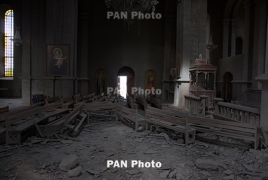
As Azerbaijan moves is taking control of territory ceded by the Armenian side in Nagorno-Karabakh, many scholars and cultural leaders are voicing concern for the fate of the region’s rich Armenian cultural and historic sites, the Smithsonian magazine says in an article published on Tuesday, November 24.
Dan Weiss and Max Hollein, the president and director of the Metropolitan Museum of Art, respectively, released a statement advocating for the renewed protection of cultural heritage in the region.
Russian Foreign Minister Sergey Lavrov recently stated that the preservation of both churches and mosques will be a main focus of the peace deal. Additionally, report Sophia Kishկovsky and Nancy Kenney for the Art Newspaper, UNESCO general director Audrey Azoulay has proposed that the United Nations carry out an inventory of the most significant cultural monuments in the area “as a prerequisite for effective protection of the region's heritage.”
The Smithsonian says for many, such concerns are made all the more urgent by the Azerbaijani government’s history of systemically destroying indigenous Armenian cultural heritage—acts of both warfare and historical revisionism. In a major report published in Hyperallergic in 2019, United States-based researchers Simon Maghakyan and Sarah Pickman, working with Armenia-based researcher Argam Ayvazyan, found that the Azerbaijani government has secretly destroyed a striking number of cultural and religious artifacts in the late 20th century.
Within Nakhichevan, a historically Armenian enclave in Azerbaijan, Azerbaijani forces destroyed at least 89 medieval churches, 5,840 khachkars (Armenian cross stones) and 22,000 historical tombstones between 1997 and 2006. In another more recent example of destruction, video footage recorded in 2005 depicted the Azerbaijani military destroying what was left of Djulfa, a medieval necropolis that once housed tens of thousands of khachkars dating back to the sixth century A.D., as Dale Berning Sawa reported for the Guardian in 2019.
In a recent Wall Street Journal opinion piece, Christina Maranci, a scholar of medieval Armenian art and architecture at Tufts University, voiced grave concern for the fate of Armenian cultural sites that will trade hands in the peace settlement. She notes that in October, Azerbaijani forces launched two targeted attacks on the Holy Savior Ghazanchetsots Cathedral in Shushi, “a masterpiece of 19th-century Armenian architecture and a landmark of Armenian cultural and religious identity.”
Carnegie Europe researcher Thomas de Waal, meanwhile, has written for Eurasianet that Armenians fear that multiple historic churches in the region are seriously threatened by the new arrangement. Among others, the list of potentially at-risk sites includes the 12th-century Dadivank monastery in Kelbajar region, archaeological site of the old city of Tigranakert in Aghdam and the Tsitsernavank basilica, a fifth- to sixth-century monastery near the Lachin district.
Just two years ago, major American institutions celebrated Armenia’s culture heritage with large-scale exhibitions. The Met’s exhibition on Armenian medieval art, “Armenia!”, documented the cultural achievements of the Armenian people over 14 centuries, from fourth-century conversions to Christianity at Mount Ararat to Armenian merchants who controlled a global trade network in the 17th century.
That same year, the Smithsonian’s Folklife Festival celebrated contemporary Armenian culture and its ongoing exchange with numerous diaspora communities around the world. To mark the occasion, Smithsonian magazine rolled out robust coverage of Armenian culture and history.

